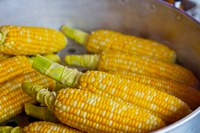Prairie Fare: Sweet corn and summer flavors — A recipe and a memory
(Click an image below to view a high-resolution image that can be downloaded)
“No playing with your food, please,” my mom said.
I had been caught.
I looked up from my plate and grinned. I had capped most of my teeth with corn kernels, giving myself a golden smile.
I was very young at the time, I will add.
I think everyone at the table laughed. I quickly swallowed the corn kernels.
That day, we had harvested and husked tubs of sweet corn to freeze. The adults cut the corn from the cobs. We had some left to enjoy for dinner.
Corn on the cob, or off the cob, was a treat in late summer — cooked and served with butter, salt and pepper.
Sweet corn is especially appealing because of its naturally sweet flavor. It is very different from dent corn, which is used for animal feed.
Corn or “Zea mays” can be considered a vegetable or a grain. Nutritionists consider corn a starchy vegetable. Dried corn kernels can be processed into cornmeal for use in muffins and bread.
Sweet corn contains the B vitamin, folate, and the mineral, iron — nutrients that can help reduce the risk for anemia and other issues. Folate helps prevent birth defects.
Sweet corn is high in insoluble fiber, which feeds your beneficial gut bacteria, aiding digestion and promoting regularity.
Corn is a member of the grass family, making it a cousin to rice, wheat and sugar cane. We eat the seeds, or grain, of this family.
Locally grown sweet corn is available at farmers markets, roadside stands and grocery stores during summer. We might see fields of corn with brownish husks indicating it is ready to be picked. If you peel back the husk, look for plump milky kernels to gauge ripeness.
While corn might be dismissed as “just a starch,” it provides valuable plant pigments — lutein and zeaxanthin — that are notably good for eye health. They may reduce our risk for age-related macular degeneration, a leading cause of blindness.
Spinach, romaine lettuce, bell peppers, parsley, egg yolk and other foods also contain lutein or zeaxanthin.
Corn is not a high-calorie food. A 6-inch ear of corn (about ½ cup of kernels) without added toppings has 60 calories, 0.5 gram (g) fat, 2 g protein, 14 g carbohydrate, 1.5 g fiber and just 2 milligrams of sodium.
Corn can be frozen, canned or dried.
Corn can be frozen on or off the cob. To freeze corn on the cob, be sure to blanch (or heat treat) the corn on the cob in boiling water, with the time dependent on the size of the cob. To blanch, bring water to a boil, add the cobs and then begin the timing process when the water begins boiling again.
Water blanch small ears (1¼ inches or less in diameter) for seven minutes, medium ears (1¼ to 1½ inches in diameter) for nine minutes and large ears (more than 1½ inches in diameter) for 11 minutes. Cool promptly and completely in ice water. Drain and package; press out air from the bag. Seal and freeze.
If you’d like to freeze corn kernels and other vegetables, check out “Freezing Vegetables” from North Dakota State University Extension. Click on the publication file, which is a printable PDF.
If you decide to preserve your food in jars, be aware that whole kernel corn is a low-acid food that must be pressure-canned for safety. See “Home Canning Low-acid Vegetables” from NDSU Extension for details on canning corn.
To dry corn, see “Food Preservation: Drying Vegetables” from NDSU Extension.
Sweet corn is more than a tasty summer treat — it’s rich in fiber and eye-healthy nutrients. Don’t miss your chance to enjoy it fresh, such as in this recipe filled with seasonal garden bounty.
Fresh Corn Salsa
4 ears fresh corn, kernels removed
1 cup green bell pepper, chopped
½ cup red onion, chopped
2 tomatoes, chopped
2 garlic cloves, chopped
2 tablespoons lemon juice, fresh or bottled
½ teaspoon black pepper
¼ teaspoon salt
Prepare ingredients as directed. Combine all ingredients in a large bowl. Refrigerate for at least 1 hour before serving. Enjoy with crunchy tortilla chips or crackers.
Makes eight servings. Each serving has 60 calories, 0 gram (g) fat, 2 g protein, 14 g carbohydrate, 2 g fiber and 60 milligrams sodium
(Julie Garden-Robinson, Ph.D., R.D., L.R.D., is a North Dakota State University Extension food and nutrition specialist and professor in the Department of Health, Nutrition and Exercise Sciences.)
NDSU Agriculture Communication – Aug. 14, 2025
Source: Julie Garden-Robinson, 701-231-7187, julie.garden-robinson@ndsu.edu
Editor: Dominic Erickson, 701-231-5546, dominic.erickson@ndsu.edu




